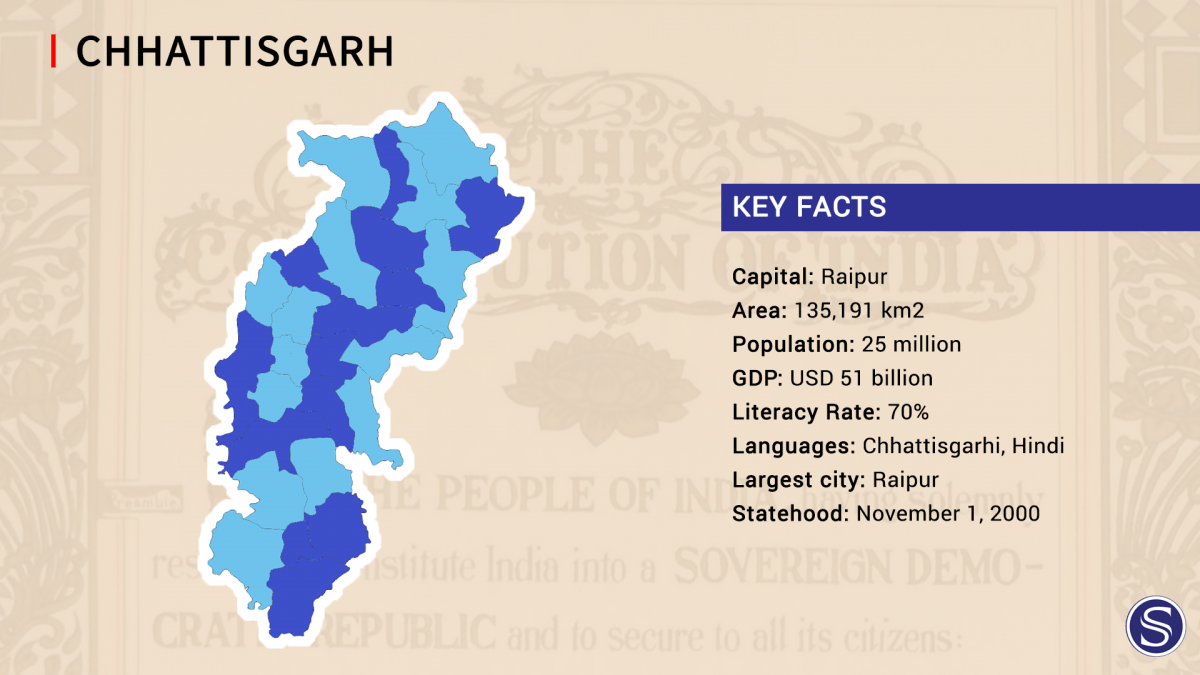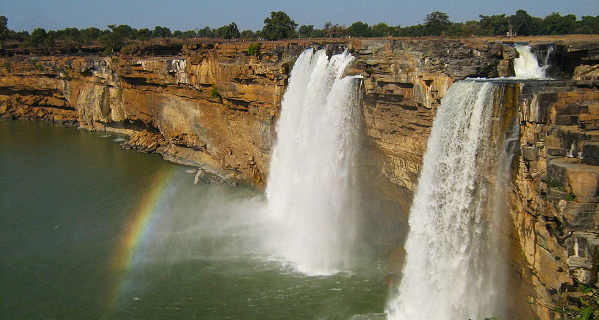Chhattisgarh: The mineral hub of India
April 4, 2019 | Expert Insights
State Profile Chhattisgarh
Key Facts
Capital: Raipur
Area: 135,191 km2
Population: 25 million
GDP: USD 51 billion
Literacy Rate: 70%
Languages: Chhattisgarhi, Hindi
Largest city: Raipur
Statehood: November 1, 2000

Background
Chhattisgarh is one of the 29 states of India, located in the centre-east of the country. It is the tenth-largest state in India, with an area of 135,191 km2 (52,198 sq mi). With a 2011 population of 25.5 million, Chhattisgarh is the 16th-most populated state in the country. A resource-rich state, it is a source of electricity and steel for the country, accounting for 15% of the total steel produced. Chhattisgarh is one of the fastest developing states in India.
The state was formed on 1 November 2000 by partitioning 10 Chhattisgarhi and 6 Gondi speaking southeastern districts of Madhya Pradesh. The capital city is Raipur. Chhattisgarh borders the states of Madhya Pradesh in the northwest, Uttar Pradesh in the north, Jharkhand in the northeast, Maharashtra in the southwest, Telangana in the south, Odisha in the southeast. Currently the state comprises 27 districts.
The 1990s saw more activity for a demand for the new state, such as the formation of a statewide political forum, especially the Chhattisgarh Rajya Nirman Manch. Chandulal Chadrakar led this forum, several successful region-wide strikes and rallies were organised under the banner of the forum, all of which were supported by major political parties, including the Indian National Congress and the Bharatiya Janata Party.
The new National Democratic Alliance (NDA) government sent the redrafted Separate Chhattisgarh Bill for the approval of the Madhya Pradesh Assembly, where it was once again unanimously approved and then it was tabled in the Lok Sabha. This bill for a separate Chhattisgarh was passed in the Lok Sabha and the Rajya Sabha, paving the way for the creation of a separate state of Chhattisgarh. The President of India gave his consent to the Madhya Pradesh Reorganisation Act 2000 on 25 August 2000. The Government of India subsequently set 1 November 2000, as the day the state of Madhya Pradesh would be divided into Chhattisgarh and Madhya Pradesh.
Profile
1) Tourism: Chhattisgarh, situated in the heart of India, is endowed with a rich cultural heritage and attractive natural diversity. The state is full of ancient monuments, rare wildlife, exquisitely carved temples, Buddhist sites, palaces, waterfalls, caves, rock paintings and hill plateaus. There are many waterfalls, hot springs, caves, temples, dams and national parks, Tiger reserve and wildlife sanctuaries in Chhattisgarh. Despite its natural advantages, the state is unable to attract a large number of tourists, both domestic and foreign and hence, does not generate significant revenue from tourism.
2) Education: Chhattisgarh's literacy rate has seen a massive boost over the past decade, jumping from 64% in 2001 to over 70% in 2011. The state has seen a transformation in the education sector this decade by setting up a national law school, an IIT, an IIM and several other institutes of higher education.
3) Infrastructure: the state accounts for 1/6th of Indian Railways’ annual revenue due to its central location and natural resources. Despite this, Chhattisgarh has a 1,187-kilometre-long (738 mi) railway line network, which is less than half of the national average of rail density. In order to lower costs for the mining and processing industries, more railway lines are required, particularly for intra-state transport of raw materials.
Assessment
Our assessment is that Chhattisgarh’s 11 Lok Sabha seats were projected to be safe in the BJPs’ column but the 2018 Vidhan Sabha elections saw the INC rise to claim a comfortable majority. We believe that for the upcoming elections, Chhattisgarh will a contested state despite all 11 present MPs being from the BJP. We also feel that the INC will try to win the state in order to open up a clear coalition path from Central to Eastern India.
Image Courtesy: Mashooque14 [CC BY-SA 4.0 (https://creativecommons.org/licenses/by-sa/4.0)]


